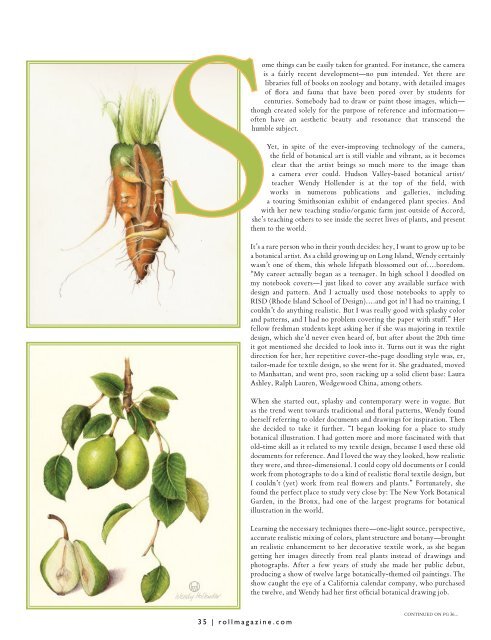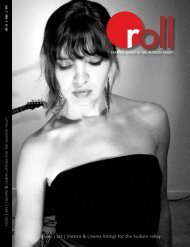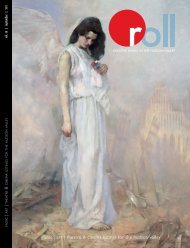music | art | theatre & cinema listings for the hudson ... - Roll Magazine
music | art | theatre & cinema listings for the hudson ... - Roll Magazine
music | art | theatre & cinema listings for the hudson ... - Roll Magazine
You also want an ePaper? Increase the reach of your titles
YUMPU automatically turns print PDFs into web optimized ePapers that Google loves.
35 | rollmagazine.com<br />
ome things can be easily taken <strong>for</strong> granted. For instance, <strong>the</strong> camera<br />
is a fairly recent development—no pun intended. Yet <strong>the</strong>re are<br />
libraries full of books on zoology and botany, with detailed images<br />
of flora and fauna that have been pored over by students <strong>for</strong><br />
centuries. Somebody had to draw or paint those images, which—<br />
though created solely <strong>for</strong> <strong>the</strong> purpose of reference and in<strong>for</strong>mation—<br />
often have an aes<strong>the</strong>tic beauty and resonance that transcend <strong>the</strong><br />
humble subject.<br />
Yet, in spite of <strong>the</strong> ever-improving technology of <strong>the</strong> camera,<br />
<strong>the</strong> field of botanical <strong>art</strong> is still viable and vibrant, as it becomes<br />
clear that <strong>the</strong> <strong>art</strong>ist brings so much more to <strong>the</strong> image than<br />
a camera ever could. Hudson Valley-based botanical <strong>art</strong>ist/<br />
teacher Wendy Hollender is at <strong>the</strong> top of <strong>the</strong> field, with<br />
works in numerous publications and galleries, including<br />
a touring Smithsonian exhibit of endangered plant species. And<br />
with her new teaching studio/organic farm just outside of Accord,<br />
she’s teaching o<strong>the</strong>rs to see inside <strong>the</strong> secret lives of plants, and present<br />
<strong>the</strong>m to <strong>the</strong> world.<br />
It’s a rare person who in <strong>the</strong>ir youth decides: hey, I want to grow up to be<br />
a botanical <strong>art</strong>ist. As a child growing up on Long Island, Wendy certainly<br />
wasn’t one of <strong>the</strong>m, this whole lifepath blossomed out of….boredom.<br />
“My career actually began as a teenager. In high school I doodled on<br />
my notebook covers—I just liked to cover any available surface with<br />
design and pattern. And I actually used those notebooks to apply to<br />
RISD (Rhode Island School of Design)….and got in! I had no training, I<br />
couldn’t do anything realistic. But I was really good with splashy color<br />
and patterns, and I had no problem covering <strong>the</strong> paper with stuff.” Her<br />
fellow freshman students kept asking her if she was majoring in textile<br />
design, which she’d never even heard of, but after about <strong>the</strong> 20th time<br />
it got mentioned she decided to look into it. Turns out it was <strong>the</strong> right<br />
direction <strong>for</strong> her, her repetitive cover-<strong>the</strong>-page doodling style was, er,<br />
tailor-made <strong>for</strong> textile design, so she went <strong>for</strong> it. She graduated, moved<br />
to Manhattan, and went pro, soon racking up a solid client base: Laura<br />
Ashley, Ralph Lauren, Wedgewood China, among o<strong>the</strong>rs.<br />
When she st<strong>art</strong>ed out, splashy and contemporary were in vogue. But<br />
as <strong>the</strong> trend went towards traditional and floral patterns, Wendy found<br />
herself referring to older documents and drawings <strong>for</strong> inspiration. Then<br />
she decided to take it fur<strong>the</strong>r. “I began looking <strong>for</strong> a place to study<br />
botanical illustration. I had gotten more and more fascinated with that<br />
old-time skill as it related to my textile design, because I used <strong>the</strong>se old<br />
documents <strong>for</strong> reference. And I loved <strong>the</strong> way <strong>the</strong>y looked, how realistic<br />
<strong>the</strong>y were, and three-dimensional. I could copy old documents or I could<br />
work from photographs to do a kind of realistic floral textile design, but<br />
I couldn’t (yet) work from real flowers and plants.” Fortunately, she<br />
found <strong>the</strong> perfect place to study very close by: The New York Botanical<br />
Garden, in <strong>the</strong> Bronx, had one of <strong>the</strong> largest programs <strong>for</strong> botanical<br />
illustration in <strong>the</strong> world.<br />
Learning <strong>the</strong> necessary techniques <strong>the</strong>re—one-light source, perspective,<br />
accurate realistic mixing of colors, plant structure and botany—brought<br />
an realistic enhancement to her decorative textile work, as she began<br />
getting her images directly from real plants instead of drawings and<br />
photographs. After a few years of study she made her public debut,<br />
producing a show of twelve large botanically-<strong>the</strong>med oil paintings. The<br />
show caught <strong>the</strong> eye of a Cali<strong>for</strong>nia calendar company, who purchased<br />
<strong>the</strong> twelve, and Wendy had her first official botanical drawing job.<br />
c o n t i n u e d o n p g 36...




